How to Sell Info Products
MicroConf founder Rob Walling recently made an announcement. All previous MicroConf talks are now in public access. This is incredible. You can access all talks on their Youtube Channel.
It seems very weird to me that there are only 2.6k subscribers as of 4/22/2020.
There is a ton of incredible content to go through.
One of the first videos that I have noticed was Adam Wathan’s presentation on selling info products. I am a huge fan of Adam and his work. He had been producing incredible content for a long time. He has made more than $2.5 million from selling his products, so you might want to listen to this guy.
This talk is no exception. It is packed with useful advice. I urge you to watch the talk. It is only 40 minutes long. In case you don’t have the time, I hope you will find the notes I made useful.
I couldn’t resist making these notes. I will be leveraging them heavily going forward. I am thinking about creating a book about Gridsome. To be more specific on how to create a personal website with it. Thanks to Adam, I have a clear roadmap on how to make sure my future product is successful.
Please enjoy!
Why Info Products (books, courses)?
- One-time purchase is easier to sell.
- Much easier to finish. There is an end in mind.
- The payout is the opposite of SaaS (starting low and getting higher). You will sell a lot and then go down.
Step 1. Build an Audience
- This is the most crucial step for any future success.
- One of the advantages is that audience makes up for any deficiency in your marketing.
How do I build an audience?
- Be helpful on the internet.
- Help people where they are (in a Twitter timeline, for instance.)
Step 2. Come up with an Idea
How to come up with an idea?
Ideas will come to you! Post useful stuff, people will engage, and ideas will come. No need to sit and brainstorm.
Make sure to record ideas when they come to you.
Tips on coming up with ideas for an info product:
- What are people liking from what you post?
- What are you excite about, that other people might be excited about.
- What did you have to figure out yourself but was helpful to learn?
- Can you make it easier for others to learn this?
Step 3. Test your Idea
- Do “tip tweets” for the subject you plan to produce.
- If this gets traction, do something more in-depth like a blog post.
Tip: Catalog any useful feedback you get about your content. Twitter replies, blog post comments, etc. Not only will this direct you, but it will also be reused later.
Step 4. Create a Landing Page
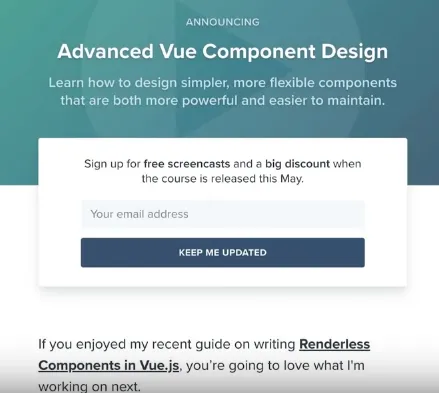
These are the things you need on your Landing page:
- Headline
- Short Description
- Call to Action: Signup to Email Newsletter
- Tip: make sure to provide an incentive: e.g., free screencasts, discount on launch.
- Proof that you know some of this stuff. Link to a blog post, for example.
- Social Proof: Testimonials, use the Tweet you saved earlier.
- Outline what you are going to include. No need to go too in-depth.
- Another signup form on the bottom.
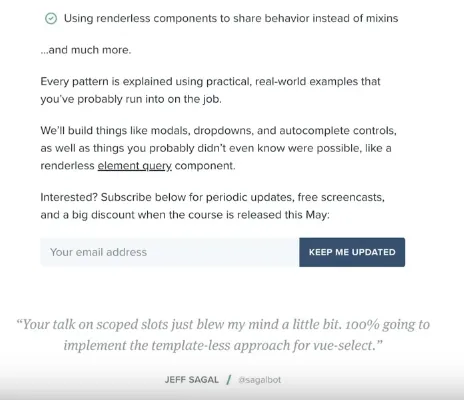
- “Who am I” section.
Adam’s Advanced Vue Course - Example
Step 5. Build an Email List
-
Tell your audience about your launch.
- Tell them you have a landing page where they can sign up.
- Announce that you are about to announce your landing page.
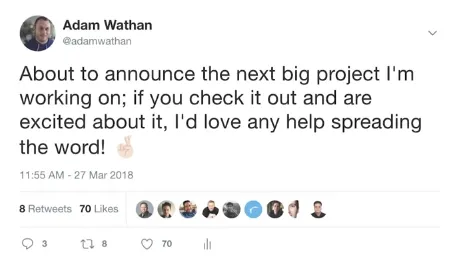
-
Share Progress with your email list.
- Every week or so, send an updateCreated to your audience. Include a free video or a link to a live stream.
- Every week or so, send an updateCreated to your audience. Include a free video or a link to a live stream.
- Share before sending an email. Tweet to your audience that if they want to receive some free stuff to go ahead and signup.
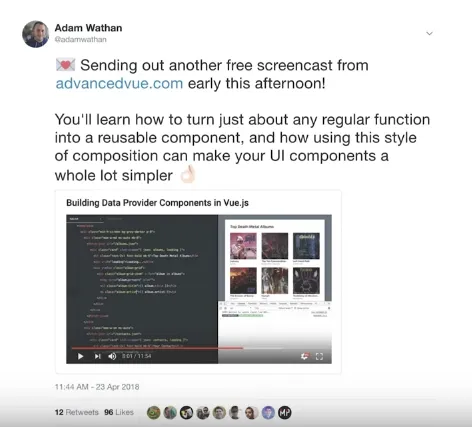
-
Repurpose Content.
- Taking a chapter from the book and massaging it into a blog post.
- Add a signup form to that post.
Step 6. Getting it finished
- Make public promises to your audience.
- Email on Schedule. Once a week is good.
- Reduce Scope, if you can’t finish, but have produced good material already.
Step 7. Figure out Pricing
1. Tiered Pricing
Single Tier
- Can be fine if you charge enough
- Often necessary if pre-selling
- Nice if you can’t figure out a way to add extra tiers that actually feel valuable
Two Tiers - Wes Bos Example Real product id the “upper” tier. “Lower” tier is like a crippled version of the “upper” tier. The real goal of that “lower” tier is to “push” people towards the upper tier. 2 products are $10 apart, but the second one has twice as much content.
Works well with video courses.
Three Tiers
- great for books if you can come up with bonus content.
- Makes it easier to evaluate as its own product instead of comparing to Amazon book prices
- Prices are usually 1, ~2, ~5x.
- This will make you a lot more money from a book than selling the book on its own.
2. Launch Discounts
- Discount it by enough to be appealing, at least 30%
- Use stepped discounts. Lower discounts on cheaper tiers and better discount on higher tiers
- Reverse engineer non-discounted price from your planned discounted price
- i.e., If you want to charge $100 for your course and want to create a 30%, don’t apply that discount to $100. Rather price your product at $143 (100 / 0.7), which will turn into $100.
- We all have a tendency to undervalue our own work.
Step 8. Nailing the Launch
1. Build a Sales Page.
- Don’t try to sell too hard, since most of the visitors will come from an email.
- Still include a signup form that sends preview content for new traffic, i.e., “Signup to get 4 free preview lessons.”
- Testimonials and Social proof are important; use feedback from preview content to start.
- Sort tiers from highest to lowest price, use visuals to communicate to higher tiers.
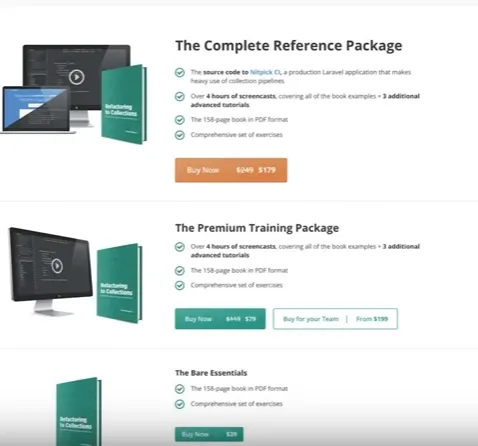
2. Announce the Launch Details
- Send an email notifying people you include the following:
- Include al package and pricing details
- Complete TOC or content list
- Final free content if possible
3. Launch it
- Send a super-simple email, saying it’s done and a link.
- Sending on Tuesdays seem good day to send to Adam, not stats.
- Morning EST works well for Adam.
4. Leverage Early Feedback
- Collect the feedback.
- Use it in a follow-up email to people who did not buy the course.
5. Closing the Launch
- Email to notify people that this is the last email where you can buy this at this price. LAST CHANCE!
- Don’t specify a closing dateCreated in advance.
- Don’t specify a closing dateCreated in advance.
Other tips:
Books vs. Video Courses
- Plan small; it will end up bigger than you think
- Short books are still books
- 3 hours is plenty for a video course
- Books are a lot easier to work on, especially if you only have short blocks of time.
- Courses are easier to sell at a higher price but a lot harder to produce on nights and weekends.
Should I pre-sell?
Advantages:
- best form of product validation
- you’ll make more money since you can talk about your product more often. With every updateCreated, for instance.
- you’ll make more money since you can talk about your product more often. With every updateCreated, for instance.
- more motivation to finish
Disadvantages
- Selling multiple tiers is trickier
- Can’t easily change the scope
- Can be extremely stressful